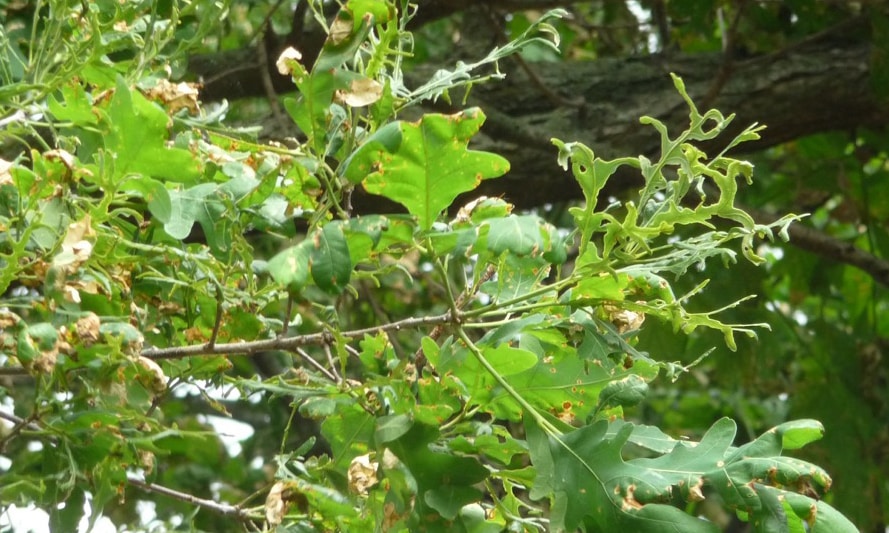By Kim Erndt-Pitcher
In spring, we ran an article on the 2017 expanded use of the highly toxic weed killer Dicamba, asking people to be aware of and report herbicide damage on gardens, woodlands, specialty crops, and roadside remnant prairies. So far, Missouri and Arkansas officials have placed an emergency ban on the sale and use of Dicamba due to extensive damage caused by drift. While the ban in Missouri has been lifted, more specific and intense application restrictions (to existing extensive application guidelines) have been mandated.

Here in Illinois we have heard from many of you who have seen the tell-tale effects of growth regulator herbicides (like Dicamba and 2, 4-D) on crop fields, forested areas, and on rare roadside/railside prairies. Personally, I have seen dozens of examples of herbicide damage while driving to meetings and walking through friends’ properties and farms. We know that our native redbuds are extremely sensitive to growth regulating herbicides and are often the “canary in the coal mine,” showing us cupped leaves. It is suspected that tatters found on oak leaves are also symptoms of herbicide damage. It makes me wonder what else is being affected and what are the secondary impacts to these non-target plant communities which also face other pressures such as shifts in invertebrate communities, increased competition from invasive species, and a changing climate.
The amount of pesticides (herbicides, insecticides, and fungicides) the U.S. uses in a year is staggering (over 1 billion pounds). When we look at pesticide use on agricultural lands, the average conventional farmer sprays his or her field three to five times, killing off competing weeds and fungi. This is in addition to using seeds coated with bee-killing neonicotinoids and other chemicals. (Note: Many stores and nurseries sell ornamental plants treated with neonics as well, so these contaminated plants could be in your flower garden).
Neonicotinoids are another class of pesticides that have been under scrutiny for their damaging effects. In 2013, Europe temporarily banned the use of neonicotinoid pesticides, and a total ban is now up for review. While this is an extremely heated issue, the high toxicity of neonics to bees is undeniable and the evidence that they pose threats to non-target organisms such as other insects,1 birds,2 and aquatic ecosystems1, 3 is rapidly mounting. However, the U.S. continues to use them unchecked on GMO corn, soybeans, sunflowers, and in the growing of many ornamental plants utilized in landscaping.
It has been shown that neonics weaken honey bee colonies and increase rates of queenlessness.4 Additionally, this same study found that when coupled with a common fungicide, acute toxicity to neonicotinoid pesticides doubles, a finding that speaks to the threats of environmental interactions between chemicals. We study honeybees because they are colonial and easily moved to study sites, and we have an intimate knowledge of their behaviors and survival needs. This is less true of the approximately 4,000 native bee species in North America and the countless other invertebrates that may be impacted by neonics. How do we know what is happening with them, particularly without baseline data on presence/absence/behavior and diversity? Also important to note is that neonics are systemic in nature and are present in many parts of the plant (tissue, roots, pollen, nectar & and even in the soil). Therefore, the chemicals are more likely to move through the environment in dust, pollen, nectar, water, etc.5

We must remember that we cannot disconnect what we do to the land from what happens in the water. From just studying neonicotinoid insecticides, researchers have found neonics in pooled water along agricultural fields where invertebrates, birds, and other animals may drink or feed.6 We know these chemicals are also entering our streams at levels where they can harm instream invertebrate communities. These same invertebrate communities that keep streams healthy are also food for other wildlife.7 For example, in the Netherlands research found that surface water concentrations of neonics was linked to declines in insect-feeding birds.2 And you might have heard that in Iowa, researchers found neonics in treated drinking water for several weeks after the planting of corn and soybeans.8 Again… what we do on land we also do to the water.
Prairie Rivers Network is part of ReGenerate IL, an effort to help strengthen and support a truly local food system; one that is deeply rooted in regenerative agriculture practices that reduce or eliminate chemical use, bring more biodiversity to the farm, and provide farmers the opportunity to grow what they want—how they want—in ways that protect our soil, air, and water. There are many angles (education, advocacy, policy, fostering champions) in which we need to approach these complex issues. But if we want to protect our water resources for generations to come, then we must look at how we live on the land and examine the things that are hidden from our sight.
Note: For links to the publications referenced in this post, click here.







